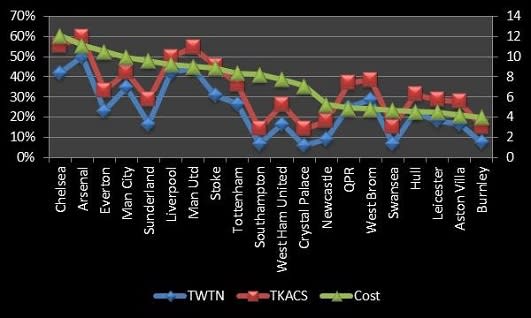By The Numbers: Week 1
Hello, my name is Rob Allen, and welcome to my new column. You should be able to tell from the title that the focus of this column is taking a statistics-based approach to the Premier League in an effort to help predict results and strong fantasy performances. In order to achieve this goal, I’ll look at betting markets, statistical distributions, forecasting tools amongst others and, where possible, share cheat sheets that you can print off and use as quick tools to make your selections.
As the new season isn’t under way yet and it’s very hard to use data from previous seasons with any confidence, I have chosen this week to use the current betting markets to help you choose your goalkeeper based on the dreaded concept of ‘value’.
Check out more Rotoworld Premier League Season Preview: Monday Morning Manager | By the numbers: QPR | Burnley | Leicester City |
Yahoo! Fantasy Bargains | Overrated Players | Underrated Players | World Cup Hangovers
The value debate rages on
The concept of value has been bandied about in Premier League and fantasy circles for at least the last five seasons, probably longer. The concept can be simply explained; if two players cost the same amount then the one who scores the most points is considered to offer better value. Similarly, if two players score the same number of points, or are expected to, then the cheaper player offers the better value. The pursuit of value therefore gives you the ability to spend more money elsewhere and effectively maximise your return.
Whilst the above definition is infallible, the debate has continued unchecked. Can a player who costs £30m offer value? How can you quantify value for a "high variance" player who tends to score either a small or enormous amount in any given week but is rarely in the middle? Should you ever choose a player who doesn’t offer value? What’s the best way of defining whether a player offers value (many of you will have heard the standard – “he must return in points the same amount as his cost”). I personally have been locked in discussions with other bloggers for hours and I’m still on the fence on some points.
What I do agree on is that if I can find a player who is anticipated to score well and doesn’t cost as much as other players, then I’m happy and with the money I’ve saved I can buy Wayne Rooney (top pick for week 1 surely…).
Picking from those pesky shot-stoppers
Picking a goalkeeper is a double edged sword – they can give fantastic returns but they also score negative points far more regularly than any other position. To help me choose I’m using two betting markets, ‘to win to nil’ (TWTN) and ‘to keep a clean sheet’ (TKACS). If you look through the scoring tables for Yahoo Fantasy Football you’ll see that two of the main ways that goalkeepers score points are keeping a clean sheet (5 points for a CS) and being on the successful team (4 points for a team win). As the first market is effectively the same as the second with the addition of overall team success, it is seen as the ideal, with TKACS seen as the minimum requirement.
You’ll probably be aware that you can turn betting odds from fractions, to decimals and then to probability percentages. This means that if a bookmaker offers odds of 5-1 on Mignolet keeping a clean sheet, this can be expressed as 6 in decimals or as 16.6% as a probability. The following graph puts together proportionally the percentage probabilities of success for each goalkeeper based on these two betting markets (the left hand axis) with the fantasy cost (the right hand axis).

If we take Southampton for example, you’ll see that there is a significant gap between their probabilities of success compared to the cost of their goalkeeper, intimating that you’re paying too much for a suspected poor performance. On the flip side, you can see that West Brom has a price that is far lower proportionately than their goalkeepers’ chance of both keeping a clean sheet and winning to nil, intimating that you’re getting more bang for your buck.
Effectively, it is these later points where expected performance exceeds the current costs that the much discussed ‘value’ appears to lie. I have chosen my selections below based on keepers whose cost is equal to or lower than both their TWTN and TKACS percentage. The only caveat I can add is that I have based the costs where possible on the goalkeeper most expected to play – for example this means Green for QPR, even though he has been replaced by Murphy at half time during the last few pre-season games.
So, to get value for money from your goalkeeper bring in:
Manchester Utd – I have used the price for De Gea but if he fails to get past his injury any replacement is likely very well priced;
QPR;
West Brom;
Hull.
Others are close and indeed some have a probability of keeping a clean sheet that is better than their cost – the most prominent being Szczesny (although with only 3.4% of FF managers owning him it would appear that he’s too expensive). Interestingly the keeper with the highest ownership percentage at the moment is Krul who by this approach isn’t an attractive choice.
So that wraps up this week’s column, I hope it’ll help with one of the hardest selections in your team. I’ll be back next Tuesday with some more numbers fun. Please contact me if you have any questions or requests and I’ll see what I can fit in, and don’t forget…..Wayne Rooney…
Follow the RotoWorld_PL team on Twitter: Galin | Jeremy | Neal | Nik | Steve | Ben | Rob | Aaron
